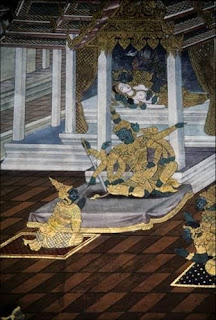King Ravana's kingdom was Lankapura. The kingdom is almost disappeared today. But If you keen on Sri Lankan folklore and ola manuscripts there you can find some remaining sites of Lankapura today known as Seegiriya and Trincomalee.
King Ravana invented the bow of Violin. He also narrated very first Ragas, the musical compositions of Eastern classical music known as Lanka Dehena and Sinhala. Siva thandawa is one of the great devotional compositions done by him, which is still being in use in
He was the first king flew over the world with his aero plane, known as Dandumonaraya or Vimanaya, Kashtawahana.
Some evidence of Dandumonaraya the aeroplane is found in Rock inscriptions, Jataka Stories and Ola manuscripts. The Sinhalese folk stories are enriched with Ravana Stories.
King Ravana was continuing a vegan oriented life style and was a real nature lover. According to Lankavatara sutta he was Buddhist and worshipped Kashyapa Buddha. Once he invited Kashyapa Buddha to visit Lanka and deliver his sermon to Sri Lankan citizens who practice yoga and follow Buddhism.
Today the time has changed and many of us do not know the real history of king Ravana and throw our folk tales away without considering any valuable parts of them. King Ravana was one of the best emperors found in Sri Lankan History.
There are more than 300 Sinhalese village names related to king Ravana era. In addition, there are some more places and remains in which the Rama Ravana war took place in
Information that we have available today of King Ravana (also spelled Rawana) seems to consist of a combination of historical fact, hero/anti-hero fiction and mythological lessons.
Most sources agree that he reigned on the island that is now known as
Ravana's parents were reportedly King Visravasmuni (or Visrawasa) and his second wife Kesini (or Kaikasi or Kaikesi). Almost all sources agree that Ravana was a devotee of Shiva who named him Ravana, whereas his original name was Dashanan (or Dasagriva). Some sources claim thatRavana was a Tamil.
Ravana's father was also reported to be a Brahmin sage called Vishrava, which makes him a Brahmin, and because of his penance and devotion to the god Brahma, he was granted a boon: it was impossible for anything to kill him, except man.
He seems to have lived about 5000 years ago and is credited by some sources with building a temple in honour of his parents that is still standing today. It is called the Isurumuniya. Other sources say that the temple was built by King Devenampiyatissa. The existence of this temple, among other factors, is proffered as evidence that Ravana was a real person and not just a mythological figure.
It is interesting to discover that most of the historic texts that mention Ravana are Indian (Hindu), not Sri Lankan. The most well-known is the Ramayana, an epic poem of 24,000 couplets in seven books, which tells the tale of how Ravana abducted king Rama's wife Sita, which led to a protracted war in which Ravana was eventually defeated by Rama with the help of the monkey king and the monkey general. The Hindu feast of Dussehra celebrates the death of Ravana, or more accurately, the victory of good over evil, while Divali (Diwali, the festival of lights) is said to celebrate the victorious homecoming of Rama and Sita.
There are a number of depictions of Ravana, most showing him either with 20 arms or with 10 heads, or both, and often with blue skin. These attributes are all said to be representative and not literal - indicating mastery over knowledge and limitless greed.
One curiosity that most sources do not fail to mention, is the flying chariot, the Pushpaka Vimana, which Ravana stole from his brother. It is described as "that aerial and excellent chariot going everywhere at will". This is not the same as the horse-drawn chariots described in earlier texts, but seems to depict a flying machine - whether this was real or wishful thinking remains an unresolved question.
Although Ravana is best-known as the evil demon who dared to abduct the most beautiful woman in








